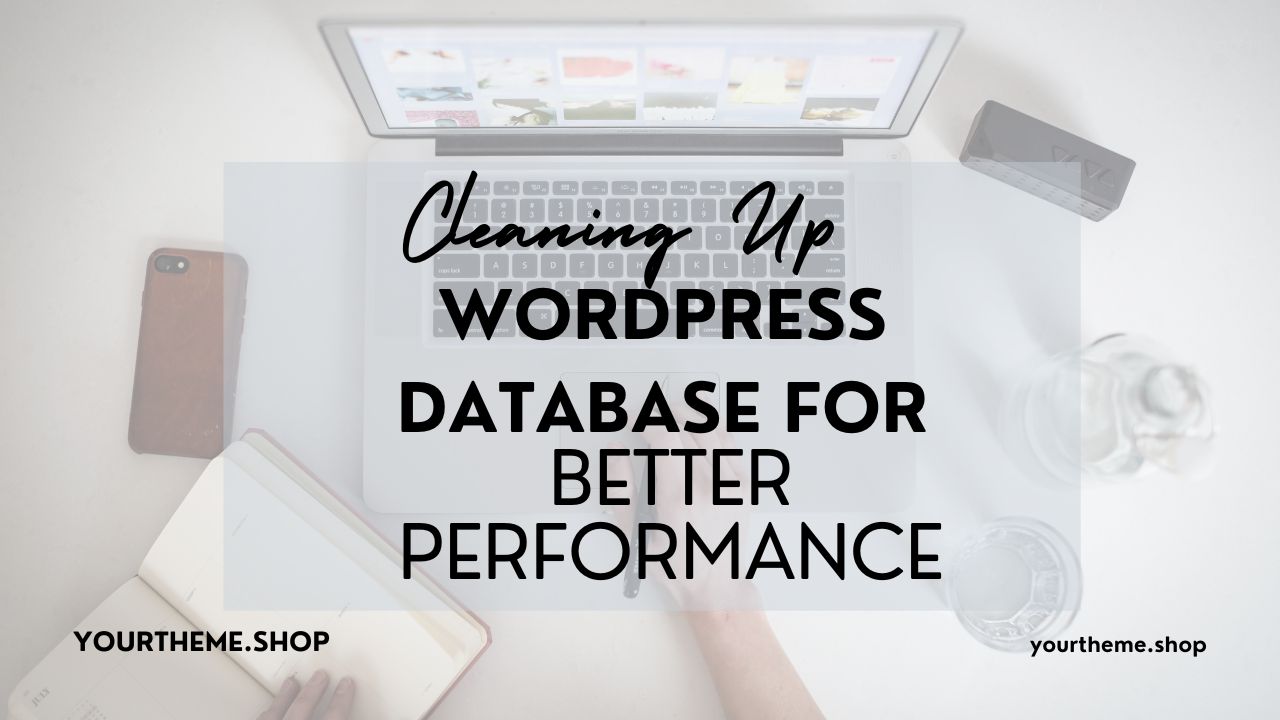In the digital world where performance is key, cleaning up your WordPress database for better performance is essential. A well-optimized database is the backbone of any efficient WordPress site, ensuring faster load times and a smoother user experience.
Cleaning Up Your WordPress Database for Better Performance
Identifying Areas for Cleanup
The first step in cleaning up your WordPress database is to identify redundant data, such as spam comments, old revisions, and transient options. This process is crucial for maintaining a lean and efficient database.
Benefits of a Clean and Efficient Database
A streamlined database enhances site speed and performance. Regular cleanup reduces server load, leading to improved website responsiveness and user satisfaction.
Database Cleanup Plugins for Improved WordPress Performance
Top Plugins for Database Optimization
In the quest for cleaning up your WordPress database for better performance, leveraging the right tools is crucial. Database cleanup plugins play a pivotal role in enhancing WordPress performance by automating the cleaning process. These plugins not only simplify maintenance tasks but also ensure your database operates at its optimal efficiency.
Identifying the Best Database Cleanup Plugins
Evaluating Plugin Features and Compatibility
When choosing database cleanup plugins for improved WordPress performance, consider features like automated cleaning schedules, ease of use, and compatibility with your current WordPress version. The right plugin should align with your specific database maintenance needs.
Popular Plugins for Database Optimization
Some of the most recommended plugins for WordPress database optimization include WP-Optimize, Advanced Database Cleaner, and WP-Sweep. These plugins offer a range of functionalities from basic cleanups to advanced optimization features.
Automating the Cleaning Process
Setting Up Automated Cleanups
Most database optimization plugins offer options to schedule automated cleanups. This feature is essential in maintaining a healthy database without manual intervention regularly.
Benefits of Automated Database Maintenance
Automated maintenance ensures that your database remains free of unnecessary bloat, which is crucial for cleaning up your WordPress database for better performance. It reduces the risk of database-related issues and enhances overall site speed.
Enhancing WordPress Performance with Optimized Databases
Impact on Site Speed and Efficiency
A well-optimized database significantly improves site speed and efficiency. By removing unused tables in your WordPress database and optimizing existing ones, these plugins contribute to a more responsive and faster-loading website.
Database Optimization as Part of Overall Site Maintenance
Database optimization should be an integral part of your overall site maintenance strategy. Regularly using database cleanup plugins for improved WordPress performance can lead to noticeable improvements in your site’s functionality.
Customizing Plugin Settings for Optimal Results
Tailoring Settings to Your Site’s Needs
Customize the settings of your chosen plugin to match your site’s specific requirements. This might include adjusting the frequency of cleanups or selecting specific areas of your database for optimization.
Monitoring Plugin Performance and Adjustments
After configuring your plugin, monitor its performance to ensure it meets your expectations. Be prepared to make adjustments as needed, based on the results you observe.
Advanced Features for Comprehensive Database Management
Exploring Additional Plugin Features
Some plugins offer advanced features like the ability to repair and restore databases, which can be invaluable in a step-by-step guide to WordPress database optimization.
Utilizing Plugins for Removing Unused Tables
Plugins can also be instrumental in removing unused tables in your WordPress database, which is a key aspect of maintaining database health and performance.
How to Choose the Right Plugin for Your Needs
Selecting the right plugin involves considering factors like ease of use, features offered, and compatibility with your WordPress version. Look for plugins that specifically address your site’s unique database challenges.
Step-by-Step Guide to WordPress Database Optimization
Preparing Your WordPress Site for Cleanup
Before you begin the optimization process, ensure you have a complete backup of your WordPress site. This precautionary step is vital to prevent data loss.
Detailed Steps for Database Optimization
Follow a systematic approach to clean up your WordPress database. This includes removing unnecessary data, optimizing table structures, and repairing any corrupted data.
Removing Unused Tables in Your WordPress Database
Identifying and Removing Orphaned Tables
A crucial aspect of cleaning up your WordPress database for better performance is dealing with orphaned tables. These are remnants left behind by uninstalled plugins and can significantly bloat your database, affecting its efficiency and, consequently, your site’s performance.
Understanding Orphaned Tables in WordPress
What Are Orphaned Tables?
Orphaned tables are database tables that are no longer linked to any installed plugin or theme. They usually remain in your database after a plugin is uninstalled and can accumulate over time, leading to unnecessary database clutter.
Impact on Database Performance
These unused tables can increase the size of your database, leading to longer backup times, slower query executions, and overall reduced performance. Regularly removing unused tables in your WordPress database is essential for maintaining its health.
Locating Orphaned Tables
Using Database Management Tools
Tools like phpMyAdmin can be instrumental in identifying orphaned tables. By accessing your WordPress database through these tools, you can visually inspect tables that don’t correspond to any currently active plugins or themes.
Database Cleanup Plugins for Assistance
Several database cleanup plugins for improved WordPress performance offer features to identify and manage orphaned tables. These plugins provide a more user-friendly interface for those who are not comfortable working directly with database management tools.
Safely Removing Orphaned Tables
Ensuring Data Safety
When undertaking the task of cleaning up your WordPress database for better performance, it’s crucial to prioritize data safety. Removing unused tables in your WordPress database can significantly enhance its efficiency, but this must be done with utmost care to avoid any accidental loss of essential data.
Verifying Orphaned Tables
Cross-Referencing with Current Plugins and Themes
Before deleting any tables, thoroughly cross-reference them with your active plugins and themes. This step is vital to ensure that you are not removing any tables that are still in use or critical for your site’s functionality.
Consulting Plugin and Theme Documentation
Often, plugin and theme documentation will specify the database tables they use. Reviewing this documentation can provide clarity on whether a table is genuinely orphaned or still in use.
Backup Before Making Changes
Creating a Full Database Backup
Always create a complete backup of your WordPress database before initiating any cleanup process. This precaution ensures that you can restore your site to its original state in case something goes wrong during the cleanup.
Using Reliable Backup Solutions
Choose reliable backup solutions that offer full database backups. This might include using database cleanup plugins for improved WordPress performance that also feature backup functionalities.
Careful Deletion of Tables
Identifying Unused Tables
Identify tables that are not linked to any current plugins or themes. These are typically left behind after a plugin or theme is uninstalled and are safe to remove.
Double-Checking Before Deletion
Before proceeding with the deletion of any table, double-check to confirm its status as unused or orphaned. This careful approach is a crucial part of the step-by-step guide to WordPress database optimization.
Monitoring Database Performance Post-Cleanup
Tracking Changes in Performance
After cleaning up your WordPress database, monitor your website’s performance. Look for improvements in loading times and overall site responsiveness as indicators of successful database optimization.
Using Performance Monitoring Tools
Utilize performance monitoring tools to get detailed insights into how the cleanup has impacted your database and site performance. This data can guide future optimization efforts.
Step-by-Step Guide to Removing Tables
Follow a systematic approach to safely remove these tables. This includes creating a backup of your database, verifying the orphaned status of each table, and then proceeding with the deletion.
Automating Orphaned Table Cleanup
Setting Up Regular Cleanups
Automating content syndication in WordPress for efficiency can also be applied to database management. Set up regular cleanups to automatically identify and remove orphaned tables, ensuring your database remains optimized without manual intervention.
Choosing the Right Automation Tools
Select plugins or tools that offer automated cleanup features. Look for those that specifically mention handling orphaned tables as part of their functionality.
Best Practices for Database Maintenance
Regular Monitoring and Cleanup
Incorporate regular database checkups into your site maintenance routine. Cleaning up your WordPress database for better performance should be a regular task to prevent the accumulation of orphaned tables and other redundant data.
Using Database Optimization Plugins Wisely
While database cleanup plugins for improved WordPress performance are helpful, use them judiciously. Over-reliance on plugins can lead to its own set of performance issues. Balance the use of plugins with manual checks and optimizations.
Ensuring Data Integrity During Cleanup
While removing unused tables, it’s essential to ensure that you don’t accidentally delete data critical to your site’s functionality. Always double-check before making any deletions.
Automating Database Maintenance for Long-Term Efficiency
Setting Up Automated Cleanup Schedules
Automating content syndication in WordPress for efficiency involves setting up schedules to regularly clean and optimize your database. This proactive approach ensures ongoing database health.
Tools and Plugins for Ongoing Database Maintenance
Utilize tools and plugins that offer features like scheduled cleanups, database monitoring, and optimization alerts. These tools help maintain your database’s performance over time.
Advanced Techniques for Database Optimization
Manual Optimization Techniques for Advanced Users
For those with technical expertise, manual optimization techniques can offer more control over database performance. This includes custom SQL queries and fine-tuning database configurations.
Optimizing Database Queries for Improved Performance
Optimizing your SQL queries can significantly improve database performance. Ensure that your queries are efficient and well-structured to reduce database load.
Monitoring and Measuring Database Performance
Tools for Tracking Database Health
Use monitoring tools to keep an eye on your database’s health. These tools can provide insights into areas that need optimization and track the impact of your cleanup efforts.
Interpreting Performance Metrics
Understanding performance metrics allows you to gauge the effectiveness of your optimization efforts. Look for improvements in load times, query execution times, and overall site performance.
Best Practices for WordPress Database Management
Regular Maintenance and Cleanup Routines
Establish regular maintenance routines for your WordPress database. Consistent cleanup and optimization are key to maintaining optimal site performance.
Security Considerations in Database Management
Database security is paramount. Ensure that your optimization efforts do not compromise the security and integrity of your database.



